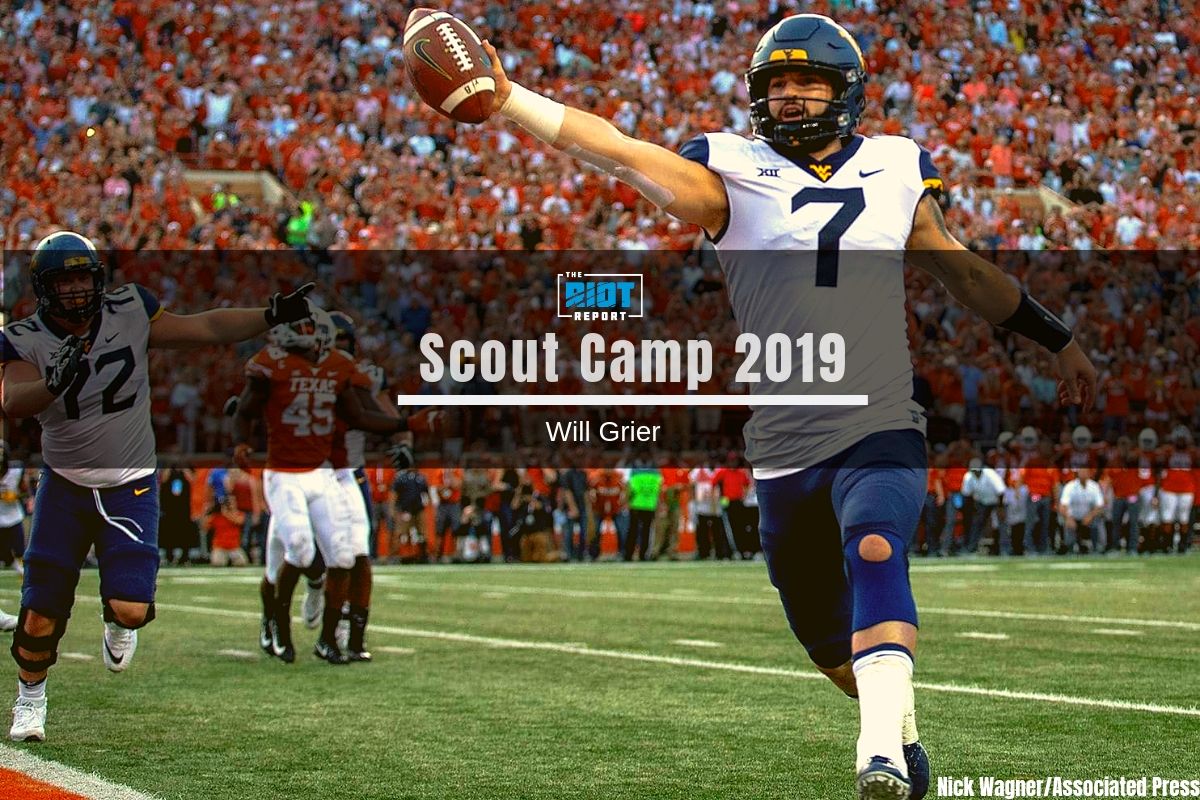The preseason is still a month away and no one has taken a snap in pads yet, but already people seem to have formed pretty strong opinions on the Panthers drafting West Virginia QB Will Grier, with some disagreeing about the Panthers’ decision to spend a third-round pick on a backup quarterback, having wanted the Panthers to address one of their other needs with this pick. This piece isn’t about that, regardless of whether you wanted the Panthers to draft Grier they have, so instead of dwelling on hypotheticals, let’s take a look at what the Panthers got when they selected Grier, and how does that fit into the Panthers’ plans going forward?
The Throwing Of The Ball
The big selling points for Grier as a prospect for most analysts before the draft were his accuracy and touch on short and intermediate routes, and this is something the tape backs up, as he repeatedly showed the ability to throw players open into tight windows:
And was able to hit players as they got open in zone on underneath routes:
These timing routes were something that West Virginia used a lot of, and the times where his accuracy did seem to leave him on tape were when he was forced to work back to receivers and wasn’t able to work his feet through a timing regime:
Misses like this certainly weren’t a frequent presence on tape, but this dependence on timing is something that I’ll come back to later. In general, however, Grier showed good accuracy and anticipation on shorter routes and while West Virginia’s offense didn’t ask him to make many intermediate throws, he did show the ability to work the ball into tight windows slightly further down the field as well:
It would be foolish at this point to ignore the elephant in the room – Grier’s arm strength. His arm certainly isn’t the strongest, and if he develops into an NFL starter, his arm would likely be in the bottom third among that group, but there are examples of players being able to succeed in the NFL with relatively weak arms.
This arm strength limitation manifests in a number of ways, and while the occasional short-hop really isn’t the end of the world:
The lack of intermediate outside throws was very noticeable on tape, and it was clear when he did attempt such passes that the lack of velocity is something that could get him into trouble against NFL defenders who will have the speed to make plays on the ball if it takes this long to arrive:
Of course, this is something that can be somewhat overcome with good anticipation – this is another trait that will be dealt with later. However, the biggest issue in terms of arm strength for Grier is what happens when one of his coping mechanisms is taken away; when he wasn’t able to step into throws and was asked to throw with just his upper body, his velocity took a notable hit:
And there are some pretty ugly underthrows:
As well as the occasional wild miss:
What this means is that Grier is fairly dependent on a clean pocket to allow him to function, as when he is asked to move his feet and throw off-base, his lack of arm strength does become pretty apparent. Again, this is something that can be somewhat overcome even without elite offensive line play, but that relies on him being able to get the ball out quickly on a consistent basis, something that – once again – will be dealt with in a bit.
On a positive note, Grier was actually able to push the ball downfield quite successfully, despite his lack of arm strength, due to his elite touch. With this, he was consistently able to drop the ball into tight vertical windows down the field, and while this isn’t going to allow him to thread seam passes against cover 2, if a receiver is able to get a step vertically, Grier was one of the best players in the draft class at being able to put the ball where only he can get it:
Interestingly, this touch was a bit less consistent on intermediate throws, as while he did throw some really nice fades:
When he was asked to throw with slightly more velocity to the back corners of the end zone, he struggled to get the required velocity at times:
As a pure thrower of the football, Grier is limited somewhat by his arm strength, and schemes which ask him to work the ball into the intermediate middle are going to be problematic for him – Atlanta, for example would not be a good fit – but he does show good accuracy on short and intermediate throws, with nice touch allowing him to push the ball downfield at times, though with all of this he is very dependent on timing to allow him to deliver the ball on time – he doesn’t have the arm to fit the ball into tight windows with arm strength alone at this time.
In order to be successful in the NFL, Grier will have to be able to work in a scheme which looks to work the ball short a lot in order to draw defenses down and then look to take advantage of this with the occasional deep shot – AKA what most think of when they imagine a Norv Turner offense. This is something that players like Alex Smith have had a lot of success with, and even players like Peyton Manning and Tom Brady have thrown the ball deep less and less as they’ve got older, but what all these players were able to do in order to compensate for this was that they could get the ball out quickly while making good decisions, allowing them to dink-and-dunk defenses a lot of the time. So how does Grier fare at this more mental aspect of playing quarterback?
Up Next: Managing The Game



